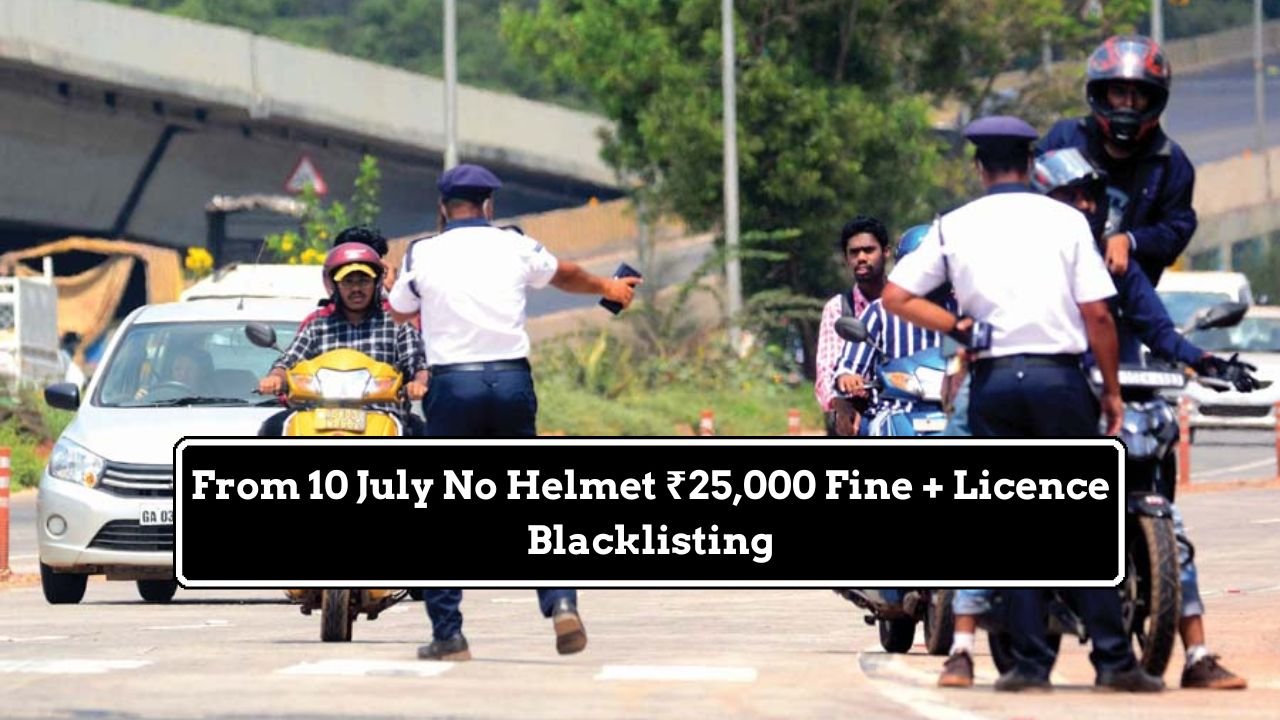New Traffic Rule: Ride Safe or Pay the Price: ₹25,000 Fine & Licence Blacklisting for No-Helmet Riders from July 10
Understanding the New Rule
Starting July 10, India is witnessing one of its most stringent traffic law updates to date. Riding a two-wheeler without a helmet won’t just earn you a modest fine or a warning anymore — it can cost you up to ₹25,000 and may even result in your driving licence being blacklisted. The move is part of an aggressive campaign by the Ministry of Road Transport to tackle the alarming rise in road fatalities involving two-wheelers.
This isn’t just a fine; it’s a statement.
Why the ₹25,000 Penalty Packs a Punch
The new fine is a sharp departure from the previous ₹1,000 penalty, meant to act as a serious deterrent rather than a slap on the wrist. Authorities argue that the nominal fines failed to change behavior on ground, especially among repeat offenders.
The ₹25,000 figure is designed to hit non-compliance where it hurts most — the pocket. And blacklisting licences introduces long-term consequences, affecting a rider’s ability to drive legally, apply for vehicle loans, or renew vehicle documents.
Helmet Stats Tell the Full Story
India accounts for the highest number of road accidents globally, and two-wheeler riders are the most vulnerable. As per data from the Ministry of Road Transport and Highways, over 43,000 motorcyclists died in 2023 alone due to not wearing helmets. What’s more alarming? Around 70% of pillion riders who died in accidents were also helmetless.
Studies show that wearing a helmet can reduce the risk of head injury by nearly 70% and the risk of death by almost 40%. Yet, compliance remains worryingly low, especially in tier-2 and rural areas.
Public Sentiment and Reactions Across the Country
While safety advocates and law enforcement officials have hailed the law as a much-needed reform, everyday commuters are divided.
- Supporters argue that the law enforces accountability and will save lives.
- Critics feel the ₹25,000 fine is disproportionately high and burdens middle- and lower-income groups.
- Younger riders, especially delivery agents and college students, have expressed concerns over affordability and access to quality helmets.
Hashtags like #HelmetHaiToSafetyHai and #FineTooHigh have started trending, reflecting the public’s polarised views.
Enforcing the Law: What Might Actually Work?
To ensure the law has real impact, states are gearing up with a multi-pronged strategy:
- AI-powered traffic surveillance cameras to automatically detect helmet violations.
- Linking violations to digital traffic profiles and DigiLocker accounts.
- Stricter checks at high-risk zones like school areas, highways, and intersections.
- Collaboration with helmet manufacturers to ensure affordable and certified helmets are accessible in rural and semi-urban areas.
Public education campaigns, especially in regional languages, are also being rolled out to bridge the awareness gap.
Practical Hurdles Ahead: Is It Too Ambitious?
Despite the bold intent, implementation isn’t without its challenges:
- Ensuring police discretion doesn’t lead to harassment or corruption.
- Infrastructure constraints in smaller towns with limited law enforcement personnel.
- Potential legal challenges or public interest litigations (PILs) questioning the penalty amount.
- The blacklisting mechanism needs to be clearly defined — will it apply after a single offense, or repeated violations?
What Other Countries Do Differently
Globally, helmet laws vary — but strict enforcement correlates with fewer fatalities.
- Vietnam mandates helmet use and enforces strict penalties; compliance is now above 90%.
- In Australia, wearing a helmet is non-negotiable, and fines can exceed ₹10,000.
- In the UK and US, while laws exist, enforcement is state-specific, and public awareness plays a bigger role than penalties.
India’s ₹25,000 fine may seem steep, but when compared to the cost of human life, it’s in line with global best practices.
Economic Implications
Beyond health and safety, the financial impact of an accident can be devastating:
- Medical bills for head injuries often run into lakhs of rupees.
- A blacklisted licence can limit earning potential for gig workers and delivery partners.
- Insurance companies may refuse claims if the rider wasn’t wearing a helmet, leaving families financially stranded.
In this light, a ₹1,000 investment in a BIS-certified helmet becomes a no-brainer.
Questions Answered
Q1. Is the ₹25,000 fine applicable on the first offense?
A: States are expected to decide based on severity and repeat offenses. First-time offenders may be let off with a lower penalty or warning in some regions.
Q2. Does this apply to pillion riders too?
A: Yes. Both rider and pillion must wear helmets, or face penalties.
Q3. What does licence blacklisting mean?
A: It could involve suspension or temporary revocation of driving privileges, with possible legal consequences on repeat violations.
Q4. Will this rule apply across all states from July 10?
A: While the central act provides the framework, states can modify implementation. Expect region-specific variations.
Final Thoughts
This law may feel harsh, but it’s a wake-up call. India loses one life every four minutes in a road accident — many of which are preventable with something as simple as a helmet.
As enforcement ramps up, the onus is now on riders to choose wisely: Gear up, or face the consequences.
Because in this battle between safety and recklessness, the helmet is your best weapon.

